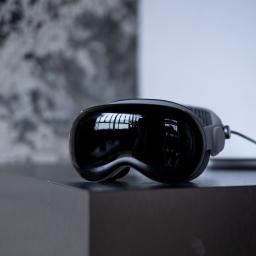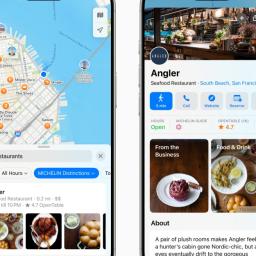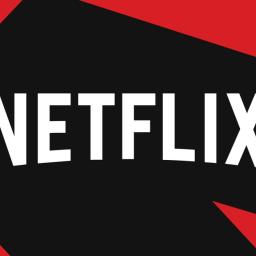 |
by Elizabeth Lopatto on (#6XAK5)
Watching the behavior of our tech overlords has answered questions I'd never thought to ask. How do you NDA an army of baby mamas? Is there anything more embarrassing than impersonating Benson Boone? (Also, who is Benson Boone?) And now, the latest: how long after a sovereign ruler of a repressive state murders one of [...]
|
The Verge
| Link | https://www.theverge.com/ |
| Feed | http://www.theverge.com/rss/index.xml |
| Updated | 2025-12-24 04:18 |
 |
by Emma Roth on (#6XAGY)
Coinbase says cyber criminals bribed and recruited" support workers to help steal customer data and trick victims into sending money to attackers. As a result of the attack, bad actors obtained the names, addresses, phone numbers, government IDs images, account data, and partial social security numbers of a small subset of users," according to a [...]
|
 |
by Elizabeth Lopatto on (#6XAGZ)
After five years, I was still happy with my phone, even though its battery had started the inevitable process of slowing to a stop. But Donald Trump's tariff nonsense pushed me to make a decision: buy a new phone or fix the old one now, before the prices go up. The answer was clearer than [...]
|
 |
by Emma Roth on (#6XADW)
YouTube now has a chart that tracks the top 100 podcasts in the US. The Joe Rogan Experience took the number one spot during the week of May 5th to the 11th, followed by Kill Tony, Rotten Mango, and 48 Hours. YouTube will update the chart every Wednesday and rank each show by watchtime, according [...]
|
 |
by Jess Weatherbed on (#6XADX)
Pinterest has apologized for a recent wave of over-enforcement" that erroneously deactivated many accounts. The platform has experienced some weird moderation issues in recent weeks, and outraged users reported their accounts had been suspended without warning or explanation. In response to many appeals, the platform cited unspecified community guideline violations. The company initially addressed ban [...]
|
 |
by Brandon Widder on (#6XADY)
May and June are rarely considered the best time of year to land a streaming deal, though that doesn't mean there aren't ways to save if you can forgo big-name services like Netflix and Hulu. Now through May 30th, for instance, both new and returning subscribers can sign up for a year of ad-supported Peacock [...]
|
 |
by Victoria Song on (#6XADZ)
Garmin's back with a bunch of goodies for runners. That includes two new Forerunner watches, a new chest strap, and several new running and triathlete features that won't be paywalled behind its newly launched Garmin Connect Plus subscription. On the watch front, there's the $749.99 Forerunner 970, which replaces the 965 as its top-of-the-line running [...]
|
 |
by Andrew Liszewski on (#6XAAH)
Audio-Technica's engineers are seemingly working overtime to elevate the design of the record player. Following the reveal of its floating, glowing Hotaru turntable last month, the company has announced its new AT-LPA2 featuring a chassis and platter made from transparent acrylic. With electronics like its power supply and playback controls packed into a separate unit [...]
|
 |
by Jay Peters on (#6XAAJ)
You might want to prepare for things to pay more at Walmart. The company's CFO, John David Rainey, told CNBC that the Trump administration's tariffs are still too high" and that consumers could see higher prices likely towards the tail end of this month, and then certainly much more in June." We're wired for everyday [...]
|
 |
by Chris Welch on (#6XAAN)
Sony's WH-1000XM6 noise-canceling headphones have arrived three years after their popular predecessors. That's a longer gap than usual for the lineup, but don't expect any earth-shattering changes. Whereas the 1000XM4 to 1000XM5 upgrade brought a significant design overhaul, this time Sony is mostly focusing on sound, noise cancellation, and quality-of-life hardware refinements, rather than messing [...]
|
 |
by Tom Warren on (#6XAAM)
Microsoft has been quietly killing off a number of Surface devices over the past few years. At first it was the Surface Headphones and Surface Earbuds that started to disappear, then came news of a changed "hardware portfolio" amid 10,000 job cuts at Microsoft in early 2023. A year later, Microsoft then killed off the [...]
|
 |
by Emma Roth on (#6XAAK)
Google is rolling out a handy update for Chrome on Android, as it will now allow you to zoom in on text without affecting the appearance of the webpage. You can use a slider to enlarge text, and then set it for one page or for all the sites you visit. Previously, when you zoomed [...]
|
 |
by Emma Roth on (#6XAAP)
Netflix is working on a new type of ad that will use AI to let advertisers marry" their product with the streaming service's shows and movies. This may sound like Warner Bros. Discovery's plan to turn its IP into commercials, but during Netflix's Upfront event on Wednesday, the company demonstrated an example that placed the [...]
|
 |
by Gaby Del Valle on (#6XA75)
Last Friday, Immigration and Customs Enforcement (ICE) agents arrested Newark mayor Ras Baraka outside a detention center. Baraka was trying to visit the facility - which opened recently and is operated by the GEO Group, a private prison company - with members of New Jersey's congressional delegation. Baraka was not only denied entry but arrested [...]
|
 |
by Jess Weatherbed on (#6XA76)
Threads is making it easier for creators to share personal links with their communities and followers. The link-sharing update announced today now allows Threads users to add up to five links to their account bios and provides performance insight that shows how many people have visited links shared in posts and profiles. Meta previously only [...]
|
 |
by Emma Roth on (#6XA77)
President Donald Trump told Apple CEO Tim Cook that he doesn't want the company to move iPhone production to India. I had a little problem with Tim Cook yesterday," Trump said during his visit to Qatar. You're coming in with $500 billion, but now I hear you're building all over India... We're not interested in [...]
|
 |
by Charles Pulliam-Moore on (#6XA78)
You're about to start seeing even more characters from Warner Bro. Discovery's films and series popping up in ads for stuff like condiments and insurance. In addition to its plan to start calling HBO Max by its proper name again, WBD announced this week that it's launching something called the WBD Storyverse," a new ad [...]
|
 |
by Andrew J. Hawkins on (#6XA7B)
We weren't that impressed with the Hummer EV when it first came out - too big, too expensive, and crazy inefficient - but we did appreciate the novelty of the Crab Walk feature that let the massive truck rotate all four wheels to drive diagonally at low speeds. Our reviewer, Emme Hall, called it the [...]
|
 |
by Andrew Webster on (#6XA79)
It's not the next mainline entry in the series, but Atlus did announced a new Persona game today. It's called Persona 5: The Phantom X, and it's a spinoff that's launching on both mobile and PC on June 26th. As the name implies, The Phantom X is set in the same universe as 2017's Persona [...]
|
 |
by Victoria Song on (#6XA7A)
You can't buy the Huawei Watch 5 in the US, but it has an interesting twist on health tracking. Most smartwatches and fitness trackers measure your metrics from a sensor array that presses into your wrist. The Watch 5 has that, but it also adds a new sensor on the watch's side that measures EKGs, [...]
|
 |
by Allison Johnson on (#6XA3N)
The Motorola Razr Ultra is something special, but it's not quite Ultra. It's gorgeous. It's a delight to use, and even after several generations of this revamped Razr flip format, checking bus arrival times on the outer screen still feels like getting away with something. This phone is a lot of things - but Ultra [...]
|
 |
by Jay Peters on (#6XA3M)
Roblox is going to let creators sell physical items from their games. The company has been testing its tools to do so since last year, but today, it's announcing that it's opening up its Commerce APIs to eligible Roblox creators. Shopify is the first integrated partner" for the APIs, and if a creator or brand [...]
|
 |
by Andrew Webster on (#6XA3P)
At its best, Netflix's Love, Death, and Robots creates the same feeling as picking up a collection of sci-fi short stories. You don't always know what to expect, and not everything is brilliant, but you're guaranteed to experience something interesting. That was especially true of volume 3 of the animated anthology, which offered nine shorts, [...]
|
 |
by Emma Roth on (#6XA3Q)
Apple is officially rolling out the next generation of CarPlay - and it's called CarPlay Ultra. The update is available with new Aston Martin vehicle orders in the US and Canada, but it will be rolling out to existing models with supported infotainment systems in the coming weeks." Carmakers like Hyundai, Kia, and Genesis are [...]
|
 |
by Tom Warren on (#6XA3R)
Microsoft is shutting off access to its Bing Search results for third-party developers. The software maker quietly announced the change earlier this week, noting that Bing Search APIs will be retired on August 11th and that any existing instances of Bing Search APIs will be decommissioned completely, and the product will no longer be available [...]
|
 |
by Abigail Bassett on (#6XA3S)
The future of everything from smartphones, to military equipment, to electric vehicles hangs on 17 rare earth minerals and the magnets that they're made into. And China, the world's largest refiner and producer, is tightening its grip and threatening the US' largest automakers. Over the last 30 years, China has methodically cornered the market on [...]
|
 |
by Jess Weatherbed on (#6XA3T)
The latest versions of OpenAI's multimodal GPT AI models are now rolling out to ChatGPT. OpenAI announced on Wednesday that GPT-4.1 will be available across all paid ChatGPT account tiers and can now be accessed by Plus, Pro, or Team users under the model picker dropdown menu. Free users are excluded from the rollout, but [...]
|
 |
by Jess Weatherbed on (#6XA1B)
Apple is trying to dissuade Europeans from using iOS apps that support alternative payment options by making them look scary. Daring Fireball's John Gruber spotted that a red exclamation mark icon is being prominently displayed on the App Store listing for Instacar, alongside a message warning users that it doesn't use Apple's private and secure [...]
|
 |
by Antonio G. Di Benedetto on (#6X9XN)
Leica is bringing a new kind of filter effect called Artist Looks" to its Lux camera app for iPhones, with the first one adjusting your photos to resemble the style and body of work of celebrity photographer Greg Williams. Artist Looks, like the other color and black-and-white looks in Leica's app, are essentially one-click filter [...]
|
 |
by Andrew Liszewski on (#6X9XP)
We Are Rewind, a Paris-based company that has relaunched the cassette player with modern features like support for wireless headphones and rechargeable batteries, has announced a larger boombox version. Streamlining the design of the portable stereos that were popular in the 80s, the 449 (around $500 USD) GB-001 can function as a Bluetooth speaker and [...]
|
 |
by Jay Peters on (#6X9RM)
EA is asking employees to return to the office for three days per week under a hybrid model - and it sounds like the company will be significantly reducing remote hiring. CEO Andrew Wilson and president of EA Entertainment and technology Laura Miele sent emails to staff about the change, IGN reports. Kotaku's Ethan Gach [...]
|
 |
by Wes Davis on (#6X9QD)
Music-sharing platform SoundCloud is saying it has never used artist content to train AI models," and that it's making a formal commitment that any use of AI on SoundCloud will be based on consent, transparency, and artist control." The update comes several days after artists reported that changes made last year to its terms of [...]
|
 |
by Jay Peters on (#6X9QE)
A leak of old text messages sent to Steam customers with one-time codes for logins was not a breach of Steam systems," Valve says in a post published Wednesday. Valve's response follows news that a hacker is allegedly in possession of 89 million user records and put them up for sale for $5,000, as BleepingComputer [...]
|
 |
by Wes Davis on (#6X9N6)
Apple is testing a feature that will let users scroll through Vision Pro apps using the headset's eye-tracking capability, according to Bloomberg's Mark Gurman. Eye-based scrolling will apparently work across all of Apple's built-in apps, and Gurman says the company is working on letting third-party developers use the feature, too. How it would actually function [...]
|
 |
by Justine Calma on (#6X9N7)
The Trump administration plans to weaken drinking water rules meant to protect Americans from forever chemicals" that have been linked to cancer, reproductive risks, liver damage, and other health issues. Last year, the Environmental Protection Agency (EPA) finalized the nation's first legally enforceable federal drinking water limits on the most common types of forever chemicals. [...]
|
 |
by Jay Peters on (#6X9N8)
Apple is updating Maps to show recommendations and information from outside sources like Michelin, The Infatuation, and Golf Digest, according to a press release. Michelin recommendations will be available first, with rankings and insights" from The Infatuation and Golf Digest added soon" and more expert sources to follow," Apple says. With this update, place cards [...]
|
 |
by Richard Lawler on (#6X9JJ)
Microsoft is testing a feature for Copilot Voice that will let Windows 11 users start a conversation with the app by saying Hey Copilot!" Windows Insiders who have the updated app can try it out once they opt in and activate the feature. Similar commands have been available for years with Siri, Google, Alexa, and [...]
|
 |
by Andrew Webster on (#6X9JK)
Netflix is adding an important category to its live offerings: talent competition. The streamer announced that it will be reviving Star Search, the classic American Idol and America's Got Talent precursor that has been off the air since 1995. The modern iteration will air live twice a week on Netflix, and viewers will be able [...]
|
 |
by Jay Peters on (#6X9JM)
Grok, the AI model from Elon Musk's xAI, was sending strange responses to people on X earlier on Wednesday. In responses to a number of people, Grok focused on debunking claims of white genocide in South Africa - even when tagged into a post about totally unrelated topics. Check out this thread to get an [...]
|
 |
by Emma Roth on (#6X9JN)
Netflix has more than doubled the number of people watching its ad-supported tier over the last year. At its upfront presentation for advertisers on Wednesday, the company revealed that the $7.99 per month plan now reaches more than 94 million users around the world each month - a big increase from the 40 million it [...]
|
 |
by Sean Hollister on (#6X9JP)
Prince of Persia: The Sands of Time Remake was originally supposed to arrive on January 21st, 2021. Since then, it's been delayed three times, got shipped to a different studio, reportedly started over from scratch, and may have lost the original writer and amazing performances of its English voice actor. But Ubisoft has revealed the [...]
|
 |
by Jay Peters on (#6X9FP)
Nintendo's Switch 2 specs page is light on details. However, Digital Foundry has shared what it says are rock solid" specifications for the upcoming console in an article and a video, offering new information about its processor and a testing tool for developers for GameChat. On its specs page, Nintendo only describes the Switch 2's [...]
|
 |
by Justine Calma on (#6X7Y4)
The US Energy Department says it's rolling back long-standing efficiency standards for appliances, which advocates are calling a clear violation of the law. Continuing the Trump administration's assault on federal water and energy efficiency programs, the department announced today what it's calling its largest deregulatory effort in history." The agency is trying to rollback 47 [...]
|
 |
by Andrew Liszewski on (#6X9FQ)
Plugable has announced a new docking solution for Windows and Mac users that supports up to five simultaneous displays, including a mix of 4K and 8K. The new $279.95 UD-7400PD dock actually supports more displays than the pricier Thunderbolt 5 docks that have recently launched which max out at three 4K screens. But Plugable's latest [...]
|
by Sheena Vasani on (#6X9FR)
Amazon's Pet Day event has arrived, making it a great time to score deals on some of our favorite pet gadgets. From self-cleaning litter boxes to treat-tossing cameras and automatic feeders, these deals are especially useful if you're heading out of town this summer. Even if you're staying close to home, though, there's something for [...]
 |
by Wes Davis on (#6X9FS)
Max, formerly HBO Max, is now HBO Max again. Warner Bros. Discovery announced the change today, rolling back one of the clumsiest rebrands in history from a streaming service that's had more than its share of clumsy ideas. Right from the start, it seemed like everyone outside of Warner Bros. Discovery knew the change was [...]
|
 |
by Andrew Webster on (#6X9CY)
Another glimpse at James Gunn's Superman just dropped - and this time things aren't looking so great for the hero. While previous looks at the movie had a more inspirational tone, the latest has the Man of Steel defending his heroic actions in an interview with Lois Lane. There's clearly going to be some conflict [...]
|
 |
by Ash Parrish on (#6X9CZ)
Square Enix has announced that it is cancelling the mobile spinoff Kingdom Hearts Missing-Link. In a statement on the game's website, Square Enix apologized to fans who were anticipating the game. The announcement also mentioned that Square was still hard at work on Kingdom Hearts IV perhaps to allay fears that this cancellation might indicate [...]
|
 |
by Andrew J. Hawkins on (#6X9D1)
Uber announced a new type of ride that travels along a set route, comes every 20 minutes, includes up to two other passengers, and costs up to 50 percent less than an UberX ride. In other words, a bus. For years, Uber and its smaller rival Lyft have been gently mocked online for occasionally releasing [...]
|
 |
by Jess Weatherbed on (#6X9D0)
TikTok is introducing new accessibility features that make it easier for people with visual impairments to see text and use screen readers on the platform. After adding alt text support for still images in April, TikTok is now testing a feature that automatically adds an AI-generated alt text description to photographs when a creator hasn't [...]
|